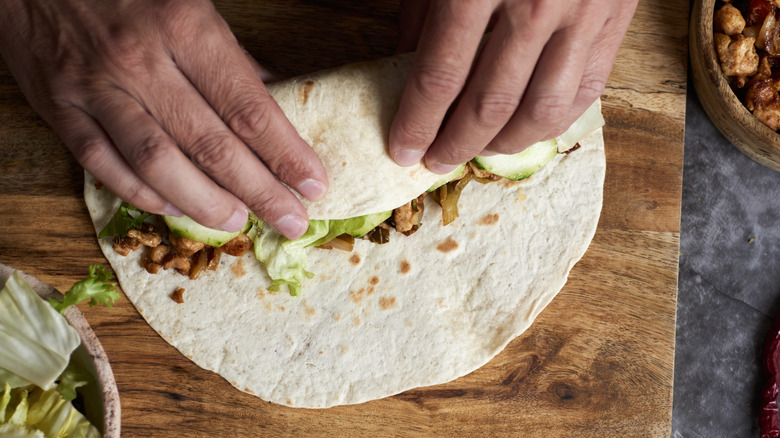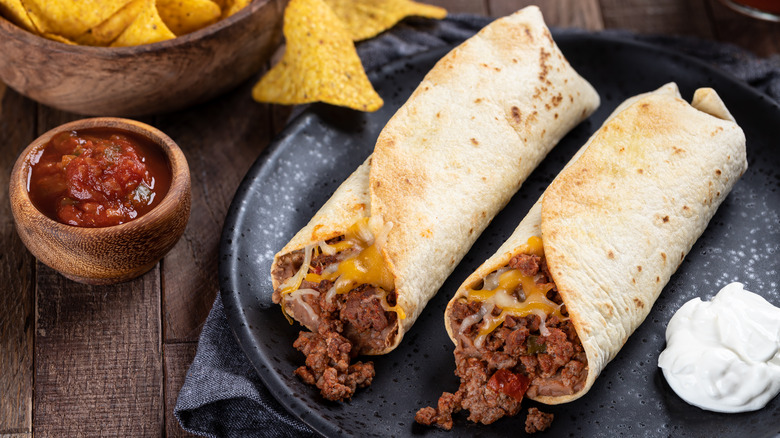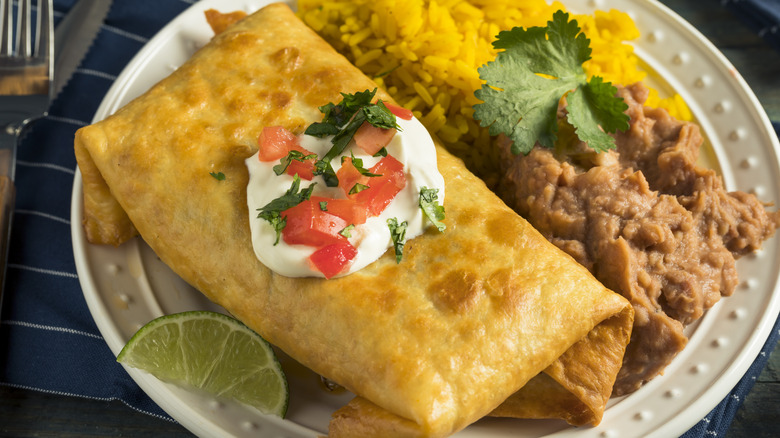The Key Difference Between Burritos And Chimichangas
The word "delicious" doesn't begin to cut it when we talk about Mexican food. Dishes filled with freshly pressed tortillas, steaming bowls of beans and rice, pork, and beef dripping with flavor after being braised in a mouthwatering mix of chili, tomato, and a boatload of herbs. The smell of cilantro, peppers, and chorizo fills the air surrounding all the Mexican food trucks and restaurants that line their way across the United States from the Pacific coast all the way through to the Atlantic.
From the heart of traditional Mexican cuisine was born a hybrid food scene known as Tex-Mex. Texas Monthly says that Tex-Mex is the culinary fusion of traditional Mexican cuisine with a little American flare that originated at the beginning of the 20th century in Mexican restaurants in the U.S. which started using yellow cheese instead of white and started deep-frying the corn tortilla.
Mexican food is inherently, regionally diverse, and Tex-Mex seems to be another branch off of Mexico's rich culinary roots. However, both are heartily sought after by hungry crowds. To the non-discerning eye, Tex-Mex and Mexican food seem to be pulled from the same well of inspiration and flavors, but there are differences. For example, per the Matador Network, in Mexican kitchens, coriander is more commonly used whereas Tex-Mex dishes incorporate cumin. Some of the most popular Mexican-inspired foods in the U.S. are the burrito and chimichanga, which, at times, are mistaken for each other due to their similarities, but they are not quite the same thing.
Burritos
Burritos are a culinary experience, so delicious and so versatile that even though we tell you that you need to try at least one, you probably need to eat at least 10 or even 20 different kinds of burritos before you understand the full scope of this dish's diversity. Masterclass describes the burrito as a flour tortilla wrapped around a variety of foodstuffs like cheese, beans, rice, meats, and veggies. Burrito translates in English to "little donkey" (possibly because the tightly wrapped food looks reminiscent of the rolled travel packs donkeys carried for travelers) and varies in style and ingredients, coming in a wild array of variants including the Mission burrito, breakfast burrito, flying burrito, and wet burrito.
Burritos, in and of themselves, are considered Tex-Mex food according to The Plaza Restaurant. This is because they use flour tortillas in place of the authentic Mexican corn tortillas, and can be jazzed up any way you like by adding eggs, and any kind of cheese your heart desires and topping them with anything from hot sauce to enchilada sauce. The burrito is traditionally eaten solo as one complete meal in and of itself due to its sheer size and heftiness, and all the inner ingredients cooked before it is built, though sometimes it is passed over a stovetop for a little extra toastiness on the outside.
Chimichangas
While the whole of a burrito might not be cooked together, the chimichanga is. The chimichanga is even more heavily influenced by American whims than the burrito it is sired from and that is because it enters the deep fryer. Seriously, what could be more American than dunking perfectly good foods in a vat of rolling hot oil? Food Network claims that the chimichanga was born around a century ago in the state of Arizona. It was the accident child of a Mexican-American restaurant in the roaring twenties. The consensus is that a cook was trying to make a burrito in a rush and mistakenly dropped their creation in the fryer.
Chimichangas today are made using a wheat tortilla, just like the burrito. Cook Think tells us that the primary filling for chimichangas is meat, whether that be chicken, beef, or seafood cooked with peppers or salsa, rolled, and plopped in the fryer. They are just as hefty as a burrito but tend to skip classic ingredients like rice and beans, and any cheese is served on top of the deep-fried creation, not inside. Chimichangas are served with sides of beans and rice and rely heavily on sauces to cut through the fatty-fried flavor of the dish. El Paso Mexican Restaurants says that the biggest differences between burritos and chimichangas are the difference in fillings (most of the burrito's filling are served as sides for the chimichanga) and the cooking method that the chimichanga experiences.


